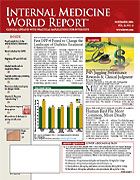Publication
Article
Internal Medicine World Report
Explain Role of Triglycerides in CV Disease to Patients
Author(s):
From the National Lipid Association Physicians-Patients Disconnect Uncovered
A new survey of 510 American physicians and 2089 patients reveals a major disconnect between information about lipids that physicians believe they are sharing with their patients and what patients actually understand.
The survey, which was conducted by the National Lipid Association (NLA), shows that most patients do not know such basic facts as the difference between triglycerides and cholesterol or that elevated triglycerides are an independent risk factor for heart disease. The patient population included 846 men and 1243 women; 248 had diabetes, and 1028 had high levels of triglycerides or cholesterol.
This first-of-its-kind survey was designed to assess current attitudes and knowledge about triglycerides and other lipids. Current trends show that about 100 million Americans have above-normal lipid levels.
IMWR
Lipids expert Jerome D. Cohen, MD, director, Preventive Cardiology Programs, St. Louis University Health Sciences Center, and chairman of the NLA Consumer Affairs Committee, told , “These findings clearly show that we as physicians need to do a more thorough job of making sure our patients understand the cardiovascular risk of unhealthy lipid levels, including the often-ignored triglycerides.”
First, he said, “doctors need to better understand the latest national guidelines, such as those promoted by the US government or the American Heart Association, for example.”
Many of the physicians surveyed said they were not as familiar with the guidelines for triglycerides as they were with the guidelines for “good” and “bad” cholesterol. Included were 205 primary care physicians, 155 cardiologists, and 150 endocrinologists.
Whereas 83% of the doctors knew that the guidelines considered normal triglyceride levels to be <150 mg/dL, only 13% of patients were aware of this important fact.
“While physicians clearly possess far more solid knowledge of desirable lipid levels and lipids in general than patients, the point is they are not reaching their patients with this knowledge,” Dr Cohen said. “Some doctors assume patients know more than they really do, but most believe [that] patients understand little about lipid problems, especially their own.”
Additional highlights from the survey show that:
• 89% of physicians knew that triglycerides are an independent risk factor for cardiovascular (CV) disease, but <50% of the patients said their physician had ever discussed triglycerides with them. When such discussions occurred, they usually lasted <5 min.
• Only 18% of patients diagnosed with dyslipidemia knew what normal triglyceride levels were.
• Only 155 of those with diabetes could identify normal triglyceride levels.
• Although elevated triglyceride levels are a greater CV risk factor for women, only 13% of the women knew the correct normal levels. Women were significantly less likely than men to have discussed triglycerides with their doctors.
“Women are especially vulnerable to elevated lipid levels,” Dr Cohen explained. “But the survey showed that only 14% of women know that hormone replacement therapy [HRT] is a risk factor for them.” Although HRT may protect bone and relieve menopausal symptoms, it has been linked to significant increases in triglyceride levels as well as an increased risk of heart attack and stroke.
When asked how a busy physician can address such a huge national issue, Dr Cohen replied, “The physician should assign skilled professional help, perhaps a nurse or a physician’s assistant, to sit down with the patients and educate them over several visits. They should start from the basics, namely, that lipids are important building blocks for energy and normal health, then focus on the components—high-density lipoprotein cholesterol, low-density lipoprotein [LDL] cholesterol, and especially triglycerides, which are still seen as the stepchild of lipid awareness.”
Knowledge of triglycerides lags behind knowledge of other lipids likely because, until about a decade ago, experts could not agree on their importance. There is now a clear consensus.
“We’ve redefined the upper limit of normal [triglycerides] from 200 mg/dL to 150 mg/dL. We also try to emphasize to patients that when levels are high, triglycerides put patients at risk for heart disease and stroke. This is where the most work is needed,” Dr Cohen stressed.
The survey also revealed that physicians generally recommend that patients manage unsafe lipid levels through lifestyle changes, such as a low-fat, low-cholesterol diet, regular exercise, and quitting smoking.
“But if lifestyle modifications don’t work, adding prescription drugs is the next best therapeutic option,” Dr Cohen said, emphasizing that all anti-lipid drugs do not work for all lipid abnormalities.
“Most statins, while very good drugs for lowering LDL cholesterol, don’t lower high triglyceride levels effectively, but fibric acid derivatives such as gemfibrozil [Lopid] and fenofibrate [Tricor] do. Niacin also may be helpful in lowering both cholesterol and triglycerides or, in certain patients, statins may be taken with a second drug [eg, ezetimibe (Zetia)] to effectively reduce LDL cholesterol. In fact, sometimes ezetimibe is used alone for patients intolerant of statins,” Dr Cohen added.
As a result of widespread direct-to-consumer advertising, patients may be tempted to self-medicate. Dr Cohen had this advice for physicians: “Urge them to follow only their physician’s instructions….As you know, anything else can be dangerous, especially when cardiovascular disease is involved.”





